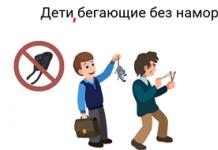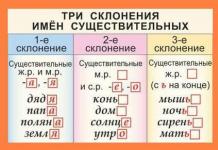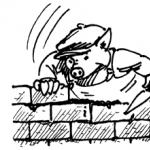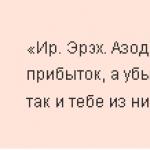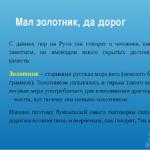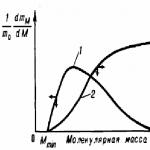Higher education in state universities in Moscow
This section contains information on state universities Moscow.
It should be borne in mind that many universities have recently created on their basis additional areas of education therefore, for a more accurate picture of the areas of study, you should pay attention to other (not specialized by its name) universities. There are medical colleges and schools for obtaining secondary medical education.
Moscow State University named after. M.V. Lomonosov (MSU)

The leading and largest university in Russia.
MSU includes 15 research institutes], 40 faculties, more than 300 departments and 6 branches (including five foreign ones - all in the CIS countries). Several years ago, a medical direction was opened - the Faculty of Fundamental Medicine. A separate modern complex of buildings was built for it (pictured).
First Moscow State Medical University named after I.M. Sechenov (MSMU)

First Moscow State Medical University named after I.M. Sechenov (Moscow Medical Academy - I.M. Sechenov MMA) - the oldest and largest domestic medical university - is the successor to the medical faculty of the Imperial Moscow University and dates back to 1758.
Moscow State Medical and Dental University named after. A.I. Evdokimova (MGMSU)

The university has highly qualified teaching staff and ranks 4th in the list of 97 specialized universities. 17.9% of teachers have academic degrees and titles of Doctor of Sciences and professors. According to this indicator, MSMSU is in 8th place according to the conclusion of the Accreditation Board of Rosobrnadzor.
Russian National Research Medical University named after N.I. Pirogov (RGMU)

One of the leading medical universities in Russia. The constantly high ratings of our university confirm the high quality of our education. Getting a medical education at our university is the key to good knowledge and prestigious work in the future.
Faculty of Medicine

Peoples' Friendship University was founded on February 5, 1960 by the decision of the USSR Government. RUDN University is the only university on the planet where students from 140 countries study annually. Currently, about 27,000 students, graduate students, residents and interns, representatives of over 450 peoples and nationalities are studying at RUDN. In order not to get lost in such volumes, we recommend using "SITE SEARCH "(top right). This tool will help you significantly simplify the search for the necessary information.
Enviable consistency - just like last year, the leading positions in terms of the level of training of first-year students who have chosen medicine are occupied by regional universities. First place in the ranking with an average score of 85.3 belongs to the Bashkir State Medical University. Next it is followed by: Voronezh State Medical Academy named after. N.N. Burdenko (85.2) and Kuban State Medical University (84.6) from Krasnodar.
As for the three Moscow medical universities, only one of them was included in the top five - Moscow State Medical and Dental University (MGMSU), whose applicants scored an average of 84.3 points per subject. Two other universities, namely, the First Moscow State Medical University named after. I.M. Sechenov (First Moscow State Medical University named after I.M. Sechenov - average score on the Unified State Exam 83.3) and the former Russian State Medical University, and now the Russian National Research Medical University named after. N.I. Pirogov (RNIMU named after N.I. Pirogov - 74.8) took seventh and ..... thirty-second places in the ranking, respectively.
| No. | The name of the university | Unified State Examination scores among those enrolled in the competition | Total accepted for budget places, persons | ||||
| Average Unified State Examination score | Unified State Exam score of the weakest | by competition | for the Olympiads | on benefits | by target set | ||
| 1 | Bashkir State Medical University, Ufa | 85,3 | 71,7 | 179 | 1 | 46 | 251 |
| 2 | Voronezh State Medical Academy named after. N.N.Burdenko | 85,2 | 73,7 | 166 | 0 | 47 | 179 |
| 3 | Kuban State Medical University, Krasnodar | 84,6 | 65,3 | 171 | 0 | 62 | 166 |
| 4 | St. Petersburg State Medical University named after. Academician I.P. Pavlov | 84,4 | 59 | 373 | 0 | 77 | 142 |
| 5 | Moscow State Medical and Dental University | 84,3 | 55 | 284 | 0 | 66 | 0 |
| 6 | Stavropol State Medical Academy | 84,1 | 74,7 | 175 | 1 | 46 | 167 |
| 7 | First State Moscow Medical University named after. I.M. Sechenov (Moscow Medical Academy named after I.M. Sechenov) | 83,3 | 50,7 | 578 | 1 | 129 | 282 |
| 8 | Nizhny Novgorod State Medical Academy | 82,8 | 71,7 | 192 | 0 | 35 | 100 |
| 9 | Dagestan State Medical Academy, Makhachkala | 81,9 | 65,3 | 344 | 0 | 81 | 59 |
| 10 | Izhevsk State Medical Academy | 81,5 | 74,7 | 185 | 0 | 15 | 122 |
| 11 | Krasnoyarsk State Medical University named after. Professor V.F. Voino-Yasenetsky | 80,7 | 73,7 | 162 | 0 | 47 | 129 |
| 12 | Samara State Medical University | 80,4 | 51,3 | 261 | 0 | 24 | 235 |
| 13 | Ryazan State Medical University named after. Academician I.P. Pavlov | 80,2 | 64,7 | 121 | 0 | 28 | 191 |
| 14 | St. Petersburg State Pediatric Medical Academy | 80 | 46 | 346 | 0 | 0 | 93 |
| 15 | Astrakhan State Medical Academy | 79,9 | 65,3 | 121 | 0 | 36 | 145 |
| 16 | Rostov State Medical University | 79,8 | 67 | 235 | 0 | 36 | 284 |
| 17 | Tver State Medical Academy | 79,1 | 67,3 | 162 | 0 | 29 | 151 |
| 18 | Kazan State Medical University | 79 | 53 | 200 | 3 | 21 | 174 |
| 19 | Smolensk State Medical Academy | 78,3 | 51,7 | 149 | 0 | 20 | 138 |
| 20 | Yaroslavl State Medical Academy | 78,2 | 68,3 | 170 | 16 | 17 | 160 |
| 21 | Saratov State Medical University | 78,1 | 56,7 | 318 | 0 | 25 | 239 |
| 22 | Chelyabinsk State Medical Academy | 77,8 | 55,7 | 303 | 0 | 16 | 116 |
| 23 | Pyatigorsk State Pharmaceutical Academy | 77,7 | 69,7 | 191 | 0 | 6 | 73 |
| 24 | North Ossetian State Medical Academy, Vladikavkaz | 77,5 | 52,7 | 135 | 0 | 0 | 136 |
| 25 | Orenburg State Medical Academy | 77,1 | 61,3 | 179 | 0 | 25 | 0 |
| 26 | Kursk State Medical University | 76,3 | 45 | 246 | 2 | 32 | 137 |
| 27 | Novosibirsk State Medical University | 75,3 | 61 | 279 | 0 | 54 | 102 |
| 28 | St. Petersburg State Chemical and Pharmaceutical Academy | 75,3 | 51 | 244 | 0 | 10 | 18 |
| 29 | St. Petersburg State Medical Academy named after. I.I. Mechnikova | 75,1 | 62 | 322 | 0 | 10 | 216 |
| 30 | Siberian State Medical University, Tomsk | 75 | 53,7 | 363 | 0 | 47 | 131 |
| 31 | Volgograd State Medical University | 74,8 | 54,3 | 405 | 1 | 43 | 158 |
| 32 | Russian National Research Medical University named after. N.I. Pirogova (Russian State Medical University), Moscow | 74,8 | 41,3 | 846 | 15 | 82 | 141 |
| 33 | Ivanovo State Medical Academy | 74,5 | 65,7 | 136 | 1 | 21 | 122 |
| 34 | Ural State Medical Academy, Yekaterinburg | 74,5 | 60 | 281 | 1 | 22 | 57 |
| 35 | Altai State Medical University, Barnaul | 74,4 | 66,3 | 182 | 6 | 29 | 215 |
| 36 | Omsk State Medical Academy | 74,3 | 63 | 179 | 0 | 23 | 168 |
| 37 | Kirov State Medical Academy | 74,2 | 64,3 | 179 | 0 | 8 | 150 |
| 38 | Tyumen State Medical Academy | 73,9 | 62 | 194 | 0 | 11 | 146 |
| 39 | Perm State Pharmaceutical Academy | 73,4 | 63,3 | 169 | 0 | 2 | 0 |
| 40 | Kemerovo State Medical Academy | 70,8 | 61,3 | 299 | 0 | 27 | 125 |
| 41 | Northern State Medical University, Arkhangelsk | 70,8 | 44,3 | 240 | 0 | 20 | 138 |
| 42 | Irkutsk State Medical University | 70,7 | 59,3 | 246 | 0 | 21 | 151 |
| 43 | Chita State Medical Academy | 69,9 | 36 | 161 | 0 | 0 | 159 |
| 44 | Khanty-Mansiysk State Medical Institute | 69,5 | 64 | 83 | 0 | 2 | 15 |
| 45 | Far Eastern State Medical University, Khabarovsk | 68,9 | 53 | 180 | 0 | 17 | 108 |
| 46 | Moscow State Academy of Veterinary Medicine and Biotechnology named after. K.I.Skryabina | 68,4 | 45,7 | 134 | 0 | 26 | 134 |
| 47 | Perm State Medical Academy | 65,2 | 38,7 | 277 | 0 | 8 | 167 |
| 48 | Amur State Medical Academy, Blagoveshchensk | 64,8 | 55,7 | 240 | 0 | 15 | 31 |
| 49 | St. Petersburg State Academy of Veterinary Medicine | 64,8 | 40 | 290 | 0 | 22 | 16 |
| 50 | Vladivostok State Medical University | 63,9 | 46,7 | 233 | 0 | 9 | 73 |
| 51 | Ural State Academy of Veterinary Medicine, Troitsk | 52,6 | 35,7 | 194 | 0 | 0 | 15 |
Medical universities in Moscow
Medical universities in Moscow, ranking of medical universities with budget places. List of the best medical institutes, universities and academies in Moscow
Searching results:
(establishments found: 5
)
Sorting:
Moscow State University named after M.V. Lomonosov is the first university to open in Russia in 1755. Moscow State University is the leading and largest university in Moscow, the center of national science and culture, one of the oldest universities in Russia.
Specialties: 19 Minimum Unified State Examination: from 282 Cost: from 270,000 rubles

The First Moscow State Medical University named after I.M. Sechenov is considered one of the oldest universities in Russia, as well as the largest medical university.
Specialties: 4 Cost:

The purpose of creating the State Classical Academy named after. Maimonides was maintaining and disseminating the culture and languages of the small peoples of Russia. The Academy trains students in the process of obtaining higher and postgraduate education.
Specialties: 9 Cost: from 70,000

Moscow State Academy of Veterinary Medicine and Biotechnology named after. K.I. Scriabin is one of the oldest educational institutions in Russia, founded in 1919.
Specialties: 6 Cost: from 40,000

Medical universities are fundamentally different from their peers in educational activities. Students undergo a unique program and study specific subjects. There is little room for theoretical research in the medical sector. Therefore, students are prepared directly for medical practice. Surgeons study anatomy and practice performing operations. Therapists study the description of the disease, its symptoms, its course and the required courses of treatment.
The best universities in this area are mainly located in Moscow. The Academy named after I.M. is recognized as the best Moscow medical universities. Sechenov Federal Agency for Health and Social Development, aka First Moscow State Medical University named after. THEM. Sechenov and the University named after N.I. Pirogov.
Medical education
But in our country there are a huge number of other incredibly strong medical universities. The quality of Russian medical education is recognized throughout the world. Russia has always been famous for its surgeons and discoverers. Thanks to our compatriots, we were able to save the lives of tens of thousands of people across the globe. Now you can make your contribution to the development of world medicine and healthcare. The strongest are still .
But youth spent studying will not be in vain. You will master the most important profession of all. In the West, doctors are respected people with very high salaries. So spare no effort and begin your long journey in medicine, because you will remember with ridicule your hesitations after yet another life you saved.
You just need to choose the field of medical science in which you want to work and choose the university that suits you. Next, you have a lot of work ahead of you on the path to mastering such a responsible profession as a doctor.
Medical universities
Before entering a university, it is best to undergo training at a medical school, where in three years you will master the basics of your future profession. The actual training at a medical university will take six years. The most difficult thing is combining university studies and work. Of course, you can devote yourself entirely to studying at the institute, but without practical skills, your education will progress very slowly. But you won’t be able to treat your studies badly: your ignorance can cost people their lives. Do you think this will all end and you will be able to start treating patients on your own? After your diploma, you need to complete an internship for a year, where you will undergo an initial internship in your chosen specialty, and then three years of residency, during which you will become familiar with all the basics of the profession. If this is not enough for you, you can continue your four-year studies in graduate school, and then enter doctoral studies, where you can study for ten years.
Medicine is truly the noblest of all arts.
Hippocrates
Since ancient times, doctors have enjoyed respect and honor among the population. This trend has continued to this day. As long as humanity and its diseases exist, doctors will also be in demand. The prestige and demand for the profession have led to high competition for admission to medical universities in Russia, of which there are currently more than 50. But given the importance of the medical profession for ensuring the health of the Russian population, colossal funds are allocated annually from the budget to finance medical education, namely, budget places in universities In 2016, huge allocations were allocated for these purposes. Therefore, despite the great competition, it is quite possible to enter medical universities.
The profession of a doctor is noble and extremely responsible, because sometimes a person’s life depends on his competence, knowledge and skill. Therefore, in medical universities, when training personnel, the following unshakable principles apply:
- quality of knowledge is high;
- the learning process is continuous, active and versatile;
- education is accessible to everyone;
- the use of innovations in the field of medicine and technology is mandatory.
Nothing is as necessary for the entire human race as medicine.
Quintilian
In addition to acquiring theoretical and practical professional skills, during the period of study the main qualities of a medical worker are introduced into the minds of students: humanity, mercy, love for their work, dedication. At its core, a doctor is not only a specialist, but also a highly educated, decent, honest person whom patients rely on in the most difficult period of their lives.
The entire educational process is controlled by the Ministry of Health and Social Development of the Russian Federation and Roszdrav.
There are medical universities in almost every region of the country, but the quality of education in them varies, depending not only on the professionalism of teachers and the students’ own desire to acquire knowledge, but also on the availability of such university infrastructure as a morgue, hospital, laboratory, hospital, clinic, library.
Medical school education does not end once you receive your diploma. This is followed by the first stage of specialization - training in internship or residency, that is, specialization in a narrow profile. And the second stage of specialization continues throughout the subsequent professional life: constant self-education, studying medical literature, advanced training once every 5 years, various internships in large medical centers, participation in conferences.
The number of medical specialties is about 150 types. In addition to the most famous and traditional ones - therapist, surgeon, dentist, gynecologist, ophthalmologist, otolaryngologist - newfangled specialties have become very popular in recent years:
- plastic surgeons;
- cosmetologists;
- chiropractors;
- phlebologists;
- acupuncturists.
The most elite medical universities providing high-quality education are:
- (MGMSU);
- Moscow Medical Academy (MMA) named after Sechenov;
- St. Petersburg Medical State University named after. Pavlova (St. Petersburg State Medical University);
- St. Petersburg Chemical and Pharmaceutical State Academy (SPHFA).
Regional medical universities also provide quality educational services. Of these, the most prestigious in 2015-2016 were recognized as BMSU in Ufa - Bashkir State Medical University and Kursk State Medical University.
The highest passing scores were required last year for admission to medical universities in Moscow, St. Petersburg, Kazan, Ufa, and Voronezh.
I believe that such interest of applicants in the university is completely justified: no matter what anyone says, they teach really well! The teaching staff is excellent, especially in physiology and biochemistry (and these are one of the most important disciplines for a future doctor). Other subjects are also taught well; the advantage is that general education subjects such as history, philosophy or economics do not require much effort; to get a pass, it is enough not to miss too many classes and write a computer-based centralized test (CT). In the main subjects we write tests almost every lesson, but the test tasks are adequate, it is not necessary to cram them, because the database has already been edited over the years.
The program is extensive and the emphasis is on self-study. There is no place for lazy people here, you need to be able to organize your time correctly, and then you can really get everything done. At the same time, it is difficult to drop out due to poor academic performance, because 6 months are given to eliminate debts, and you can take exams even without tests.
Recently, life has been simplified for students by the fact that the same tests are available in the public domain by order of the Vice-Rector for Academic Affairs, registration for retaking tests is done automatically, a personal account has been created in which the schedule, information about the appointment or withdrawal of scholarships, retakes and all CT results, in the future it is planned to publish information about the student’s attendance. This means that there are fewer reasons to stand in line at the dean’s office)
Academic buildings are located at different metro stations, but everything is within walking distance. In the 1st year, most couples will be on Izmailovskaya. 2nd year - mainly Okhotny Ryad, where the departments are a 5-minute walk.
The scholarships are not too large, but, as in all universities, they are indexed. Now students starting from the 2nd semester of the 1st year receive 3,045 rubles (a single amount, there is no division into excellent and good students), only admitted first-year students receive about 1,500 rubles per month. Starting from the 3rd year, you can apply for an increased scholarship for educational, sports and scientific achievements.
The only negative is the lack of places in budget hostels (only beneficiaries are accommodated) - they plan to compensate this year, because... The finishing touches for a new dormitory with >1000 beds are being completed.
Information for activists: our university has many sports sections, volunteering and student scientific clubs are developed.
In general, the atmosphere in the student environment is calm and friendly, studying, in my opinion, is still not as difficult as they scare applicants) Groups are most often very friendly, everyone helps each other, otherwise it is almost impossible to adapt to the pace of study from the first days. Those who enter here consciously and of their own free will, and not just at the behest of their parents, will find it interesting to study, so I wish good luck to the applicants!
|
|

